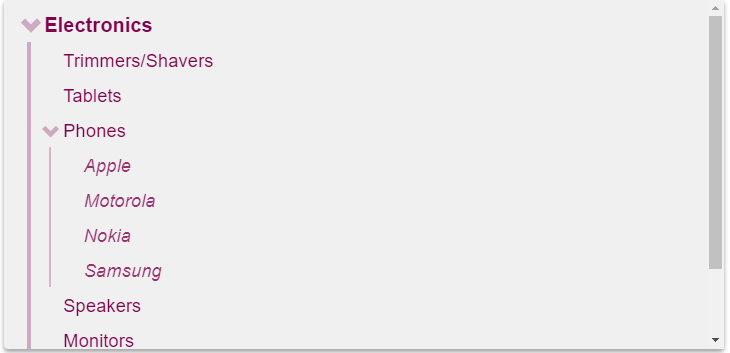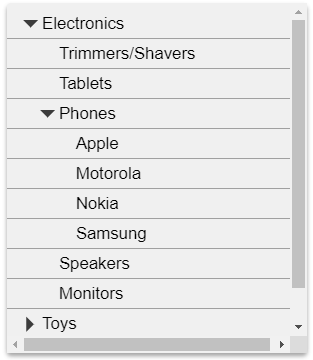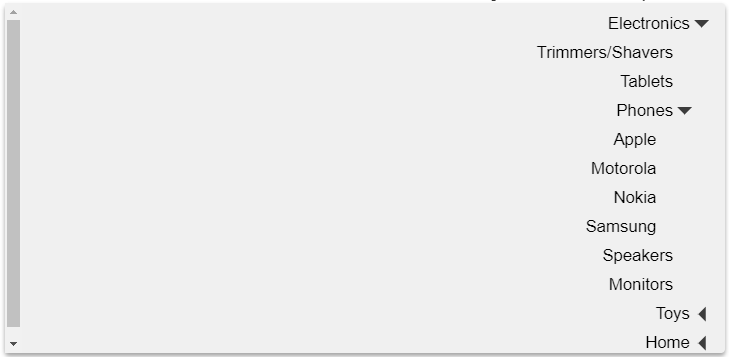5.20241.9
ツリービュー:スタイル
CSSを使用してTreeViewの外観をカスタマイズできます。次の例は、2種類のカスタマイズを示しています。
例1:折りたたみ/展開アイコンを変更し、ノードレベルに応じて異なるフォントサイズを使用して、レベル1のノードの左側に縦棒を追加します。

CSS
.custom-tree.wj-treeview {
color: #80044d;
}
/* デフォルトのノード */
.custom-tree.wj-treeview .wj-node {
}
/* レベル0以下のノード */
.custom-tree.wj-treeview .wj-nodelist > .wj-node {
font-size: 120%;
font-weight: bold;
}
/* レベル1以下のノード(小さなフォントに変更し、左側に縦棒を追加) */
.custom-tree.wj-treeview .wj-nodelist > .wj-nodelist > .wj-node,
.custom-tree.wj-treeview .wj-nodelist > .wj-nodelist > .wj-nodelist {
font-size: 110%;
font-weight: normal;
border-left: 4px solid rgba(128, 4, 77, 0.3);
}
/* レベル2以下のノード(小さなフォントに変更し、境界線を細くする) */
.custom-tree.wj-treeview .wj-nodelist > .wj-nodelist > .wj-nodelist > .wj-node, .custom-tree.wj-treeview .wj-nodelist > .wj-nodelist > .wj-nodelist > .wj-nodelist {
font-size: 100%;
font-style: italic;
opacity: 0.8;
border-left: 2px solid rgba(128, 4, 77, 0.3);
}
/* 展開されたノードのグリフ */
.custom-tree.wj-treeview .wj-nodelist .wj-node:before {
content: "\e114";
font-family: 'Glyphicons Halflings';
top: 4px;
border: none;
opacity: .3;
transition: all .3s cubic-bezier(.4,0,.2,1);
}
/* 折りたたまれたノードのグリフ */
.custom-tree.wj-treeview .wj-nodelist .wj-node.wj-state-collapsed:before, .custom-tree.wj-treeview .wj-nodelist .wj-node.wj-state-collapsing:before {
transform: rotate(-180deg);
transition: all .3s cubic-bezier(.4,0,.2,1);
}
/* 選択されたノード */
.custom-tree.wj-treeview .wj-node.wj-state-selected {
color: white;
background: rgba(128, 4, 77, 0.70);
}
/* このサンプルのデフォルトツリー */
.wj-treeview {
display:block;
height: 350px;
font-size: 120%;
margin-bottom: 8px;
padding: 6px;
background: #f0f0f0;
box-shadow: 0 3px 6px rgba(0,0,0,0.16), 0 3px 6px rgba(0,0,0,0.23);
}
body {
margin-bottom: 24pt;
}
HTML
<div id="theTree" class="custom-tree"></div>
例2:ツリーノードに下境界線を追加します。境界線をツリーの左側まで延長するには、CSSで境界線と共にpadding-leftプロパティとmargin-leftプロパティを設定します。

CSS
.custom-tree.wj-treeview .wj-node {
border-bottom: 1px solid #a0a0a0;
padding-left: 110px;
margin-left: -100px;
margin-right: -10px;
}
.wj-treeview {
width: 300px;
height: 350px;
font-size: 120%;
margin-top: 8px;
margin-bottom: 8px;
padding: 6px;
background: #f0f0f0;
box-shadow: 0 3px 6px rgba(0,0,0,0.16), 0 3px 6px rgba(0,0,0,0.23);
}
body {
margin-bottom: 24pt;
}
HTML
<div id="theTree" class="custom-tree"></div>
右から左
ページの右から左にコンテンツをレンダリングする言語もあります(典型的な例はアラビア語とヘブライ語)。HTMLは、「dir」属性を使用してこれに適応しています。任意の要素で「dir」を「rtl」に設定すると、要素のコンテンツが右から左に配置されます。
TreeViewコントロールは、これを自動的にサポートします。ツリーをホストしている要素の「dir」属性を「rtl」に設定すると、ノードが右から左に向かって自動的にレンダリングされます。

HTML
<div id="content" dir="rtl">
<div>
これは<b>TreeView</b>の前に置かれた通常のコンテンツです。
</div>
<div id="theTree"></div>
</div>
